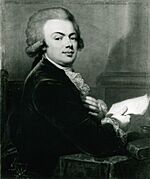Ludwik Skumin Tyszkiewicz facts for kids
Quick facts for kids
Ludwik Skumin Tyszkiewicz
|
|
|---|---|
 |
|
| Coat of arms | Leliwa – Skumin |
| Full name |
Hrabia Ludwik Skumin Tyszkiewicz herbu Leliwa
|
| Born | 1748 Vilnius, Grand Duchy of Lithuania |
| Died | 26 June 1808 |
| Family | Skumin |
| Consort | Konstancja Poniatowska |
| Issue | Anna Maria Ewa Apolonia Tyszkiewicz |
| Father | Józef Skumin Tyszkiewicz |
| Mother | Anna Pociej h. Waga |
Ludwik Skumin Tyszkiewicz (born in 1748 – died on June 26, 1808) was an important nobleman from the Polish–Lithuanian Commonwealth. He held several high-ranking positions in the government. These included being the Field Lithuanian Hetman (a military leader) from 1780 to 1791. He was also the Great Lithuanian Treasurer (in charge of money) starting in 1791. Later, in 1793, he became the Great Lithuanian Marshal, a very senior official.
Contents
Ludwik's Early Life and Family Connections
Ludwik Skumin Tyszkiewicz was born in 1748 in Vilnius, which was then part of the Grand Duchy of Lithuania. His family was part of the szlachta, which means they were Polish–Lithuanian nobles.
Marriage to a Royal Niece
In 1775, Ludwik married Konstancja Poniatowska in Warsaw. She was the niece of King Stanisław August Poniatowski. This marriage connected Ludwik to the royal family. Ludwik and Konstancja had a daughter named Anna. Anna later married Count Aleksander Stanisław Potocki.
Ludwik's Political Career
Ludwik Tyszkiewicz was very active in the politics of his time. He served in various important roles.
Starting in Politics
In 1764, Ludwik was chosen as an envoy from the Trakai Voivodeship. An envoy is like a representative. In this role, he helped choose Stanisław August Poniatowski as the new king.
Serving in the Sejm
The Sejm was the main parliament of the Polish–Lithuanian Commonwealth. In 1776, Ludwik was an envoy to the Sejm from the Vilnius Voivodeship. Two years later, in 1778, he became the Marshal of the Sejm. This meant he was the leader of the parliament. In 1782, he supported the Permanent Council, which was a group that advised the king.
Role in Major Events
During the Polish–Russian War of 1792, Ludwik made a big decision. He supported the king joining the Targowica Confederation. This group worked with Russia. Ludwik himself soon joined the Confederation and became the Grand Marshal of Lithuania.
Later, during the Grodno Sejm in 1793, Ludwik was chosen to talk with the Russian ambassador. He signed agreements that gave land to Russia and Prussia. These agreements were part of the Second Partition of Poland, where parts of the country were taken by other nations. In 1795, he led a group of Lithuanians who showed respect to Empress Catherine II of Russia.
Awards and Achievements
Ludwik Tyszkiewicz received many important awards for his service.
Royal Honors
On November 25, 1776, he was given the Order of the White Eagle (Poland). This is one of Poland's highest honors. In 1778, he also received the Order of St. Stanislaus.
International Recognition
In 1787, Ludwik received two high honors from Russia. These were the Order of St. Alexander Nevsky and the Order of St. Andrew.
Building the Tyszkiewicz Palace
In 1792, Ludwik Tyszkiewicz had a beautiful building constructed in Warsaw. This building is known as the Tyszkiewicz Palace.
See also

